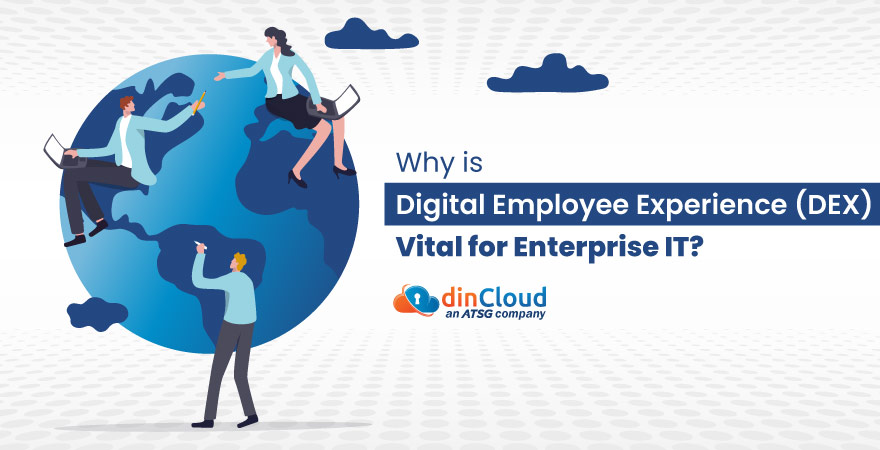In the post-pandemic era, we have seen massive changes across the enterprise. Many organizations have pivoted towards remote and hybrid work models and will continue with such arrangements for the foreseeable future.
However, hybrid and remote work settings usher in their fair share of challenges for the workforce and IT admins. In un-traditional work settings, which could be entirely new for some organizations, the employee experience is very important.

What Makes for a Good Digital Employee Experience?
In the broader sense of the word, the term Digital Employee Experience (DEX) is quite similar to Customer Experience (CX). The idea behind delivering superior customer experiences is meeting and/or exceeding customer expectations.
Well, DEX also works exactly the same way. The only difference in the case of DEX is that enterprises have to provide their employees with all the requisite tools, pieces of training, and platforms that can enable them to perform seamlessly, wherever they may be located.
In other words, a superior Digital Employee Experience (DEX) revolves around giving your remote employees the full capability to perform their day-to-day workloads with both efficiency and ease.
Related: Top Reasons Enterprises Will Continue to Adopt Cloud Desktops in 2022?
The Importance of DEX for Enterprise IT
It is easy to infer from the term Digital Employee Experience (DEX) that the IT department of an organization will be playing a very central role in any such initiative.
Keeping Enterprise Projects on Track
This example applies not only to DEX initiatives but also to enterprise workloads and projects that need to be executed. Keeping in view the relative capacity of the enterprise infrastructure, and the preparedness of employees, IT decides the pace of change.
IT teams are not only responsible for “timing” this whole Digital Transformation exercise, but also for making sure that such initiatives are also backed by the full support of IT personnel who will bring all the employees with a non-IT background, fully on-board.
Further, IT teams will make the final call, when it comes to prioritizing DEX initiatives while considering the multiple resources constraints. These constraints can be related to finances, operations, or the capacity of employees to absorb DEX initiatives with an open mind.
Related: Why & How are Enterprises Moving towards Green IT in 2022?
Prioritizing the Various DEX Initiatives
Based on the various functional areas of an enterprise, a host of different initiatives could be underway to improve the overall Digital Employee Experience. This can often result in overlap between multiple DEX tools/initiatives.
The IT teams are better aware of the technical intricacies of DEX initiatives, and implementation bottlenecks. This in turn enables IT, teams, to prioritize DEX projects in a way that they deliver the maximum value to the business, with minimal disruption.
For instance, it may have been decided by the top management to implement a Unified Communications platform, and a project management tool for improving DEX. It is for IT to decide, keeping in view the priorities and situation, which of the two will get priority.
Related: The Top Digitalization Trends for the Year 2022
Curbing Shadow IT Practices
A lot of recent cyber security studies have revealed that “shadow IT” practices expose the endpoint devices of remote employees, and the enterprise network, to a lot of risks. Shadow IT is the use of shady, pirated software by employees to get things done.
Employees resort to shadow IT practices for a host of reasons, the prime one being the inadequacy of “whitelisted” tools and platforms to fulfill employee needs. Once IT spearheads DEX initiatives, they know best the root causes of shadow IT practices.
IT professionals can pinpoint the deficiencies and problem areas within the existing enterprise applications that are impeding employee productivity. Based on these findings, IT can suggest, and implement the proper set of tools to improve the DEX, in a legit way.
Why would remote or hybrid employees resort to shadow IT practices, if they can get things done easily through their in-house tools and applications? It is pertinent to mention here that there also needs to a balance between security protocols and the usability of tools.
Related: Cloud Security Trends to Look Out For in Year 2022
DEX Initiatives Elevate the Stature of IT
Traditionally, IT leaders have been perceived as just the “implementers” or “executioners” of enterprise strategies. With DEX gaining a pivotal role in the operations of the modern enterprise, the overall stature and role of IT teams have become much more strategic.
Which, when, where, and how DEX improvement solutions will be implemented across the enterprise, are now being spearheaded by IT teams. Members of the other functional areas, on the other hand, do provide their valuable input about the different DEX initiatives.
Related: A Glimpse of the Leading Cyber Security Trends for 2022
Conclusion
IT professionals have a pivotal role to play in elevating the Digital Employee Experiences (DEX) of the modern remote workforce. However, the overall success of such initiatives depends a lot upon the ownership and support of the top management.
Unless the top management of an enterprise embraces the various Digital Employee Experience improvement initiatives, such solutions will not be able to attain a strong foundation across every tier of the enterprise.
The crux of the matter is, improved Digital Employee Experiences (DEX) lead to better employee productivity, motivation, and most importantly, retention levels. This in turn translates into better Customer Experiences (CX), and more value for the enterprise.
You can maximize the impact and value of Digital Employee Experience (DEX) initiatives with dinCloud’s best-in-class Cloud Computing solutions and services for your enterprise.


